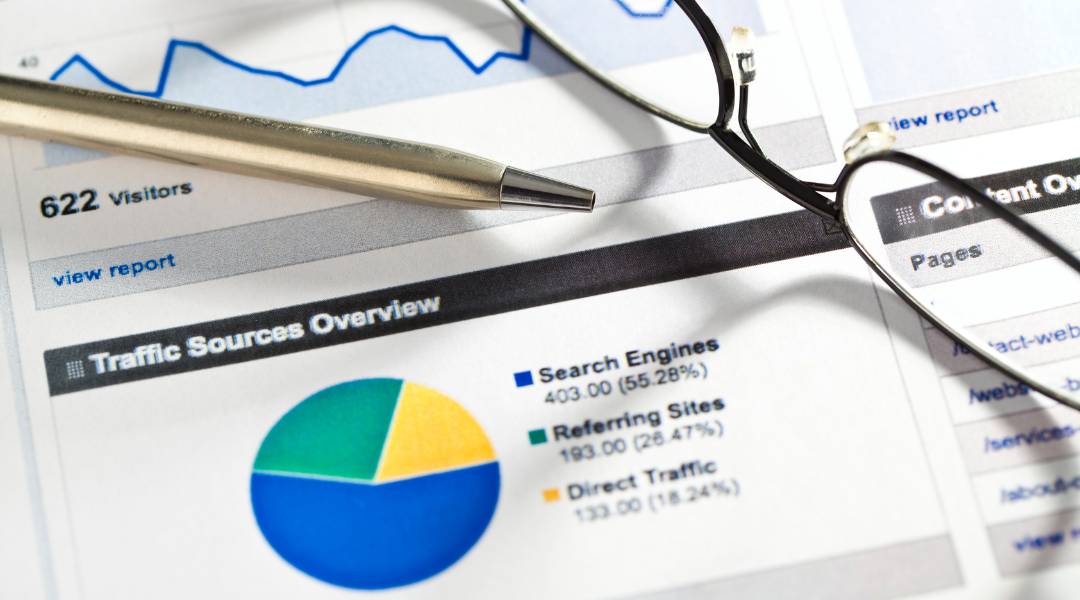Refresh your website by cleaning out the cobwebs. Getting rid of outdated content can seriously boost your search engine rankings and bring in more traffic. Think of it as decluttering; by tidying up, you present a fresher, more relevant face to the world—and notably, to Google’s algorithms.
By cleaning the house, CNET sacrificed thousands of articles, trading quantity for quality in a bold bid to rise through the search engine ranks. However, there’s nuance here because Google points out that age alone doesn’t diminish an article’s value. Indeed, pruning isn’t about discarding everything old but carefully selecting what no longer serves your site’s quality or relevance.
Identify Low-Performing Pages
To identify low-performing pages, start by diving into your analytics. Look for pages with high bounce rates and low engagement metrics such as short time-on-page or lack of social shares. These indicators often signal content that doesn’t meet users’ expectations or fails to provide value.
Furthermore, examine organic traffic trends over time; a page losing ground in search results could be falling out of favor with both users and search engines. Next, assess the relevance of each piece’s content. If information is outdated or no longer aligns with current industry standards and practices, it’s likely dragging down your site’s perceived authority and relevance.
Always check for external links before making cuts. A seemingly underperforming page might still hold strong backlinks crucial for your website’s domain authority. This is a key factor considered by Google when ranking websites according to its google ranking algorithm.
Removing these can inadvertently harm more than help. In essence, carefully evaluate which pages truly don’t contribute to your SEO performance—avoid discarding valuable assets without thorough analysis.
Improve Site Speed and Performance
Removing old or irrelevant content streamlines your site, directly impacting its speed and performance. Old pages that no longer get traffic weigh down your website, much like carrying extra weight slows you down on a hike. Think of Google’s crawlers in the same way; if they have to sift through outdated or unnecessary information, crawling efficiency decreases.
This can hinder the rapid indexing of new, relevant content. We regularly conduct an exhaustive audit with our clients using tools like Ubersuggest and Google Analytics to identify these dead-weight pages. It’s not just about deleting them; it’s about deciding whether updating them could breathe new life into them for audience relevance and organic traffic gains.
Strategically removing such content after careful evaluation aids in enhancing crawl budget allocation to more valuable pages on your site—this means improved indexing speed for fresh content, contributing positively to SEO outcomes. Moreover, employing 301 redirects wisely avoids losing any residual value from removed pages by passing it onto current offerings. However, caution is warranted—too many redirects might slow things down again!
Ultimately, boosting site health translates into better user experience, leading to potentially higher rankings in search results.
Enhance User Experience Quality
Enhancing user experience quality directly ties into updating your content. Out-of-date articles can frustrate visitors looking for current information, leading them to leave your site quickly. This increases bounce rates and decreases the chances of conversions or engagement.
By refreshing old posts with recent data and answers to common questions, you make sure users find what they need fast. It keeps them on your page longer, improving metrics like time on site that search engines use for ranking sites. Optimizing title tags and meta descriptions is also key in this process.
These elements give potential readers a sneak peek of what’s inside before clicking through from SERPs (search engine results pages). With compelling titles and clear summaries containing relevant keywords, you boost not only click-through rates but also ensure relevance at first glance. Remember to review analytics regularly using Google Analytics or Search Console tools after making updates because understanding performance changes helps tailor future enhancements more accurately.
Reduce Index Bloat on Google
Reducing index bloat directly impacts your website’s SEO performance. Google indexes every page, including those that don’t benefit visitors or your business. This overflow of low-quality pages consumes valuable crawl budget and decreases site speed, affecting user experience negatively.
To tackle this issue, you need to identify all indexed URLs using tools like Google Search Console. Discover the extent of index bloat by comparing the expected number of pages on your site against what’s actually indexed. For instance, if an eCommerce platform anticipates having around 10,000 pages but finds 38,000 listed in search results instead, there’s clear evidence of index bloating caused potentially by technical glitches that create unnecessary product pages.
After pinpointing these redundant or irrelevant URLs, removal from Google’s Index can be done through webmaster tools. Ensuring only high-value content is accessible aids in streamlining focus toward productive crawling and indexing activities. Addressing this problem maintains a streamlined and efficient online presence.
It lets search engines prioritize key areas rather than sift through extraneous data, which hampers overall ranking potential due to diluted relevance signals amongst actual useful content.
Update or Merge Content Strategically
When you think about refreshing your blog, consider the impact on user engagement. Users crave new information and insights. Even content that was once cutting-edge can quickly become stale as topics evolve.
Keeping your posts up-to-date ensures readers find value every time they visit, significantly reducing bounce rates. Secondly, fresh content ranks higher in search results because engines prioritize relevancy and freshness when indexing pages—remember seeing only recent articles at the top for many searches? That’s no coincidence; it’s by design to meet user expectations for current information.
Moreover, updating reinforces your brand’s authority. Regular updates signal to your audience that you’re a reliable source of the latest knowledge and advice within your field. This builds trust—a crucial factor in maintaining loyalty among followers or customers who rely on you for accurate data or solutions.
Leveraging existing content saves resources. It’s more efficient than starting from scratch since much groundwork has already been laid out. Choose wisely which contents to update through tools like Google Search Console, focusing mainly where improvement promises maximum returns.
Strong impressions yet low clicks indicate potential undiscovered by actual users, possibly due to outdated perspectives needing a substantive revamp to ensure relevance with present-day realities, thus enhancing click-through rates and increasing organic traffic.
Increase Crawl Budget Efficiency
Boosting your crawl budget efficiency means making sure Google spends its time wisely on your site. Since every website gets a different amount of attention from web crawlers, larger sites with lots of pages get more. But this doesn’t mean they can waste it.
If your server is slow or if you have many dead links, Google’s crawler might use up the allocated budget without fully indexing new or important content. To keep things smooth and ensure fresh content gets noticed, avoid unnecessary redirects and clean out those broken links that lead nowhere. Remember how search engines work.
They crawl to find information through links, index what they find, and rank these pages based on relevance and quality signals. Fascinatingly enough, facets like navigation systems in eCommerce can turn 100 simple product pages into thousands due to unique URL structures for filter combinations, which also eat into your crawl budget fast if not managed well. Updating content regularly tells Google your site stays fresh.
This encourages more frequent visits within the limited window available for their crawling process.
Elevate Freshness Signal with Updates
Elevating your content’s freshness isn’t just about the latest trends; it’s crucial for SEO performance. Google values up-to-date information, particularly for searches that need current insights like news or trending topics. If you’re tackling subjects where facts change quickly, regular updates can significantly boost your ranking in search results.
This doesn’t mean all your posts require constant refreshes. Evergreen material—content that remains relevant over time—still holds value without frequent modifications. However, don’t overlook competitive movements or industry shifts that might necessitate updates to keep pace with current data and perspectives.
To ensure your efforts are well-targeted, use tools like Google Analytics and Search Console to pinpoint pages needing a refresh. Assess whether these address queries demanding fresh information and aim to enhance not only the accuracy but also the depth of those selected articles. Remember, quality upgrades go beyond superficial date changes—they enrich the user experience, adding newer insights or visuals, thus making content more engaging and effective at driving traffic while adhering closely to E-E-A-T principles critical for trustworthiness on Google’s platform.
Leverage Internal Linking Opportunities
In your quest to enhance SEO performance by removing outdated content, don’t overlook the power of internal linking. These links knit pages within a site together, guiding both users and search engines through your website’s landscape smoothly. Think of them as pathways leading explorers to treasures—your articles or products—which otherwise might remain hidden.
A well-planned internal link structure not only helps prevent orphan pages but also bolsters site navigation and categorization, which is crucial for Google’s indexing algorithms. When executed with care, these links weave a network that enhances the relevance and authority of individual pages.
For optimal impact, integrate diverse types of internal links: contextual ones within post bodies offer depth; navigational ensure ease in movement; footer and sidebar varieties enrich user experience further without cluttering main content areas.










